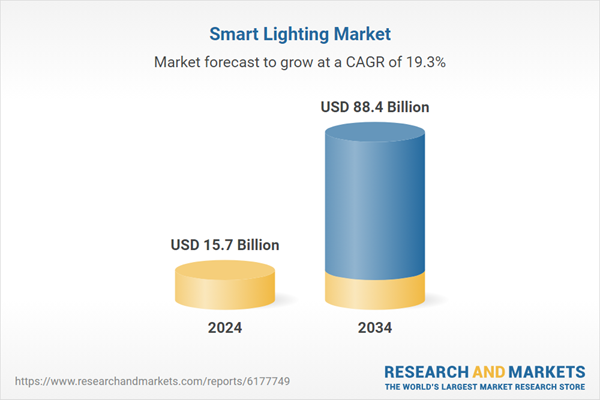Market growth is influenced by the increasing integration of intelligent lighting systems in smart city infrastructures. Governments worldwide are accelerating smart city developments with a sharp focus on sustainability, carbon reduction, and urban efficiency, where smart lighting plays a central role. These systems enable better energy management and social advancement by offering automated, responsive, and data-driven lighting control. Their deployment in public infrastructure aligns both environmental goals and improved public safety.
Smart lighting combines advanced connectivity with intelligent automation, making lighting systems more adaptive and user centric. The rise of wireless standards like Zigbee, Z-Wave, and Bluetooth has made smart lighting more accessible and interoperable with other devices. As connected living becomes more mainstream, demand for lighting systems that offer control via smartphones, voice assistants, and centralized apps continues to surge. Innovations driven by IoT are also fueling the design of smarter lighting products that respond to real-time data. Consumers increasingly value seamless integration, user-friendly interfaces, and personalization making smart lighting a critical aspect of digital home evolution.
In 2024, the hardware segment generated USD 12.5 billion. The growth of this segment is attributed to IoT-enabled components like smart bulbs, luminaires, and controllers, which support remote operation, automation, and energy optimization. To remain competitive, manufacturers are emphasizing product miniaturization, enhancing system longevity, reducing production costs, and embedding AI for smarter functionality. The demand for intelligent, connected lighting continues to push development toward more compact, efficient, and responsive devices.
The wired smart lighting segment generated USD 11 billion in 2024, supported by wired systems offering greater security, stable connectivity, regulatory reliability, and suitability for extensive commercial or public infrastructure installations. Their high transmission capacity and long-term cost advantages make them ideal for enterprises seeking consistent performance in critical applications.
U.S. Smart Lighting Market generated USD 3.2 billion in 2024. Market expansion in the U.S. is bolstered by rapid advancements in artificial intelligence and IoT, alongside strong momentum in smart home and city initiatives. With increased consumer interest in automated environments and increasing energy consciousness, adoption of smart lighting is gaining traction across residential, commercial, and industrial spaces. The integration of lighting systems into home automation platforms further enhances consumer experience and operational control, making the U.S. a prime market for ongoing innovation and growth.
Top companies in the Global Smart Lighting Market include Lockheed Martin, Dragonfly Aerospace, SpaceX, NanoAvionics, EnduroSat, ISISPACE GROUP, Space Inventor A/S, Surrey Satellite Technology Ltd, Tyvak International, CU Aerospace, GomSpace, Pumpkin Space Systems, Maverick Space Systems Inc., EXOLAUNCH GmbH, Northrop Grumman, RTX Corporation, and AAC Clyde Space. Companies operating in the Smart Lighting Market are pursuing a range of strategies to expand their global footprint and strengthen competitiveness. They are heavily investing in R&D to introduce AI-integrated, energy-efficient lighting solutions that offer enhanced automation and seamless interoperability with broader smart ecosystems. Strategic partnerships with tech companies, city planners, and real estate developers are allowing faster integration of their products in residential and commercial projects. Many players are also focusing on upgrading existing lighting infrastructures with retrofit smart modules. Product diversification into both wired and wireless segments ensures wider reach across varied consumer bases.
Comprehensive Market Analysis and Forecast
- Industry trends, key growth drivers, challenges, future opportunities, and regulatory landscape
- Competitive landscape with Porter’s Five Forces and PESTEL analysis
- Market size, segmentation, and regional forecasts
- In-depth company profiles, business strategies, financial insights, and SWOT analysis
This product will be delivered within 2-4 business days.
Table of Contents
Companies Mentioned
The companies profiled in this Smart Lighting market report include:- AAC Clyde Space
- CU Aerospace
- Dragonfly Aerospace
- EnduroSat
- EXOLAUNCH GmbH
- GomSpace
- ISISPACE GROUP
- Lockheed Martin
- Maverick Space Systems Inc.
- NanoAvionics
- Northrop Grumman
- Pumpkin Space Systems
- RTX Corporation
- Space Inventor A/S
- SpaceX
- Surrey Satellite Technology Ltd
- Tyvak International
Table Information
| Report Attribute | Details |
|---|---|
| No. of Pages | 180 |
| Published | September 2025 |
| Forecast Period | 2024 - 2034 |
| Estimated Market Value ( USD | $ 15.7 Billion |
| Forecasted Market Value ( USD | $ 88.4 Billion |
| Compound Annual Growth Rate | 19.3% |
| Regions Covered | Global |
| No. of Companies Mentioned | 18 |









